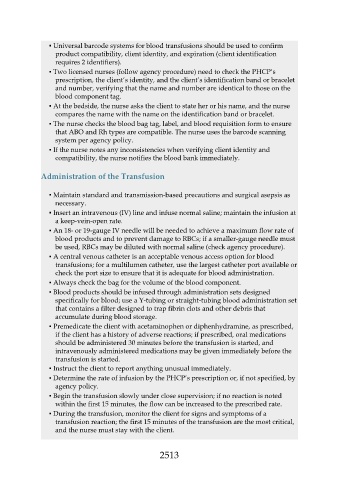Page 2513 - Saunders Comprehensive Review For NCLEX-RN
P. 2513
▪ Universal barcode systems for blood transfusions should be used to confirm
product compatibility, client identity, and expiration (client identification
requires 2 identifiers).
▪ Two licensed nurses (follow agency procedure) need to check the PHCP’s
prescription, the client’s identity, and the client’s identification band or bracelet
and number, verifying that the name and number are identical to those on the
blood component tag.
▪ At the bedside, the nurse asks the client to state her or his name, and the nurse
compares the name with the name on the identification band or bracelet.
▪ The nurse checks the blood bag tag, label, and blood requisition form to ensure
that ABO and Rh types are compatible. The nurse uses the barcode scanning
system per agency policy.
▪ If the nurse notes any inconsistencies when verifying client identity and
compatibility, the nurse notifies the blood bank immediately.
Administration of the Transfusion
▪ Maintain standard and transmission-based precautions and surgical asepsis as
necessary.
▪ Insert an intravenous (IV) line and infuse normal saline; maintain the infusion at
a keep-vein-open rate.
▪ An 18- or 19-gauge IV needle will be needed to achieve a maximum flow rate of
blood products and to prevent damage to RBCs; if a smaller-gauge needle must
be used, RBCs may be diluted with normal saline (check agency procedure).
▪ A central venous catheter is an acceptable venous access option for blood
transfusions; for a multilumen catheter, use the largest catheter port available or
check the port size to ensure that it is adequate for blood administration.
▪ Always check the bag for the volume of the blood component.
▪ Blood products should be infused through administration sets designed
specifically for blood; use a Y-tubing or straight-tubing blood administration set
that contains a filter designed to trap fibrin clots and other debris that
accumulate during blood storage.
▪ Premedicate the client with acetaminophen or diphenhydramine, as prescribed,
if the client has a history of adverse reactions; if prescribed, oral medications
should be administered 30 minutes before the transfusion is started, and
intravenously administered medications may be given immediately before the
transfusion is started.
▪ Instruct the client to report anything unusual immediately.
▪ Determine the rate of infusion by the PHCP’s prescription or, if not specified, by
agency policy.
▪ Begin the transfusion slowly under close supervision; if no reaction is noted
within the first 15 minutes, the flow can be increased to the prescribed rate.
▪ During the transfusion, monitor the client for signs and symptoms of a
transfusion reaction; the first 15 minutes of the transfusion are the most critical,
and the nurse must stay with the client.
2513

